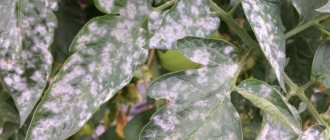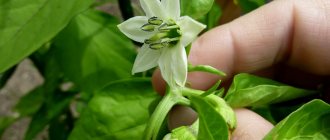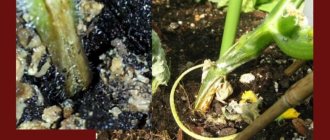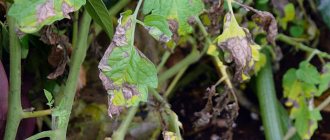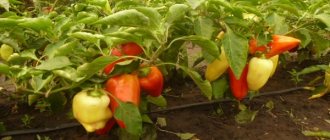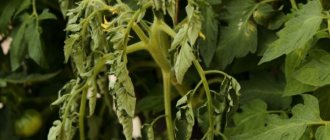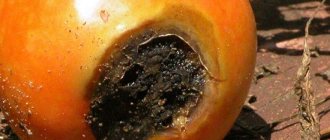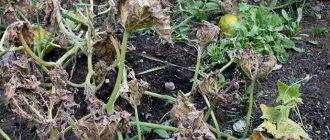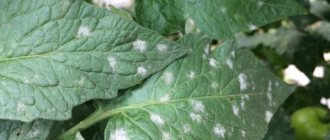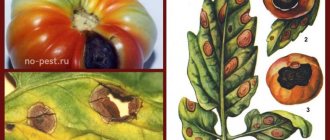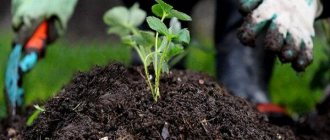Vegetable growing » Tomatoes
0
4544
Article rating
Kira Stoletova
Brown spot on tomatoes can destroy up to 80% of the tomato crop. Only the adoption of timely preventive measures and timely treatment can effectively combat the infection and preserve tomato plantings.
Fighting brown spot of tomatoes
Main symptoms of the disease
The first signs of brown spotting are the appearance of small spots of yellow, brown or brown color.
. Along the edges of the spots, a border of purple, violet or black-brown color is clearly visible. These spots are also clearly visible on the reverse side of the leaf blades. If the humidity of the air and soil is increased, then a coating of fungal spores appears on the spots.
Gradually the color of the spots becomes lighter, but their dark border remains. The tissue in the center of the spots gradually becomes thinner, and thin foliage develops holes in this place.
Photo of brown spot on leaves
On a note!
When plants are massively affected by cladosporiosis, the foliage begins to dry out and fall off ahead of schedule. In many crops (in particular, garden strawberries), up to 100% of the foliage can be affected by brown spot.
From the foliage, the disease gradually spreads to the remaining parts of the plant - petioles, shoots, fruits. Cladosporiosis contributes to a sharp decrease in yield.
Pests in the garden!
How to deal with cutworm (cabbage, potato, garden) How to get rid of wireworms How to deal with mole crickets
The fruits do not grow, begin to deform, their color changes to brown, crack and begin to crumble. New flowers and fruits do not form, and those that have already appeared dry out and fall off.
Why do brown spots appear on tomato leaves, and what to do about it?
Brown spots on the leaves and fruits of tomato bushes are a common problem, the root cause of which can be various infectious and bacterial diseases. What are the most common symptoms and treatments?
Late blight
This fungal disease is known to all gardeners, since it is the one most often found on tomatoes. It is quite difficult to figure out exactly what it is, because the general term refers to the impact of any of the 50 possible types of fungus, most of which are constantly in the ground, but become active in the second half of summer.
There are several causes of late blight:
- close placement of tomato beds to plantings of potatoes or other nightshade crops;
- dense plantings and limited ventilation between bushes;
- sudden temperature changes with high humidity levels;
- frequent and heavy rains, which is especially typical for the second half of summer;
- uncontrolled and abundant watering with irrigation of fruits and leaves;
- excess lime and nitrogen in the soil;
- lack of potassium, copper, manganese in the soil.
The main symptoms of late blight activity include:
- the appearance of brown spots on the bottom of the sheets, which grow over time, and the sheet itself becomes dry and curls into a tube;
- darkening on the green stems of the plant, causing blackening of the entire surface;
- formation of black spots on tomato fruits.
Important! Late blight has high adaptive capabilities, therefore, using the same means year after year, you will not be able to get rid of it.
In the fight against the disease, special chemicals are usually used (for example, Fundazol, Ridomil, Fitosporin, Trichopolum, Topaz), although self-prepared solutions can also be used. In the latter case, popular compositions are:
- Garlic-manganese infusion: 100 g of garlic pulp should be poured with a glass of boiling water and, after infusing for a day, diluted in water in a ratio of 1:10. You can add 1 g of potassium permanganate to the resulting composition, then pour the solution into a spray bottle and spray it on the plants.
- Straw infusion . For 1 kg of rotten hay, you need to take 10 liters of water, add a handful of urea to it and leave it all for 3-4 days. Then strain the mixture well and treat the tomato bushes with a spray bottle.
- Yeast infusion . Dissolve 80 g of crushed yeast in a bucket of warm water, let the mixture brew, and then treat the bushes with the same spray bottle.
Brown spot
Cladosporiosis (also known as brown spot) is another common variant of the fungal disease of tomatoes. Its causative agent is the fungus Cladosporium fulvum Cooce, which spreads throughout the territory along with air or water.
The main reasons for its activation are:
- relatively low temperature with high air humidity;
- growing tomatoes in places where the disease has already been noticed before;
- failure to comply with preventive measures when caring for plantings;
- excessive watering.
Among the characteristic signs of cladosporiosis, the following are primarily noted:
- light olive spots on the surface of the lower leaves of tomato bushes;
- light gray or green-brown coating on the underside of the leaf (it is this that is sprayed onto neighboring bushes, infecting them);
- dried leaves, including those located in the lower part of the bush;
- small and inconspicuous fruits, sometimes with a darkish tint.
Find out also how to get rid of caterpillars on tomatoes.
In the fight against the disease, chemical preparations from the “Bravo”, “Fitolavin”, “Ditan NeoTek” series are used, as well as compositions prepared on the basis of folk recipes:
- Garlic infusion. The crushed plant (200 g) is poured into 10 liters of water and infused for 24 hours. The finished mixture must be filtered and then treated with it on the affected bushes.
- A solution of potassium permanganate and wood ash. Potassium permanganate should be diluted in water to obtain a weak pink solution, and 300 g of ash should be mixed with 1–2 liters of water, heating the mixture to a boil. After 15 minutes, remove the liquid from the heat, cool and filter. To achieve the best effect, it is recommended to alternate treatment with ash and potassium permanganate.
If “chemical” treatment with the chosen drug does not bring the desired result, it is worth choosing another drug, supplementing it with one of the given “folk” remedies. You should not eat tomatoes immediately after processing.
Gray rot
Unlike previous fungal diseases, this infection affects fruits more, although it enters the plant through cracks and other microtraumas on the trunks.
The causative agent of the disease is the fungus Botrytis cinerea Pers, the causes of which are:
- the use of unprocessed tomato seed, sometimes collected from one’s own plot in the previous year;
- planting plants in an untreated area where diseased crops were already growing;
- violation of suitable growing conditions, sharp fluctuations in humidity levels;
- insufficient ventilation when growing in a greenhouse.
In general, these reasons are also typical for other types of rot, with different signs of manifestation.
You will be interested to know how to properly prepare a solution of iodine for processing tomatoes.
And the presence of the gray variety will be indicated by:
- grayish tint of fruits and their partial (or complete) rotting;
- “fluffy” coating on the surface of the tomato;
- the appearance of dark spots on the leaves;
- damage to the stem part of the plant.
How to deal with this disease depends on the extent of its spread. In order not to increase the scale of the problem, it is advisable to immediately use one of the specialized drugs: Topsin M, Bayleton, Euparen Multi, sodium humate. The dosage and rules for preparing the working solution are always marked by the manufacturer on the packaging.
For those summer residents who do not want to use chemicals, the only solution is to prepare homemade products from available ingredients.
The most famous home remedies against gray rot of tomatoes include:
- soap-copper solution (both ingredients are mixed in equal proportions and dissolved in water);
- solution of copper sulfate (5 g of the substance must be dissolved in 10 liters of water);
- baking soda solution (80 g per 10 liters of water);
- one percent boric acid solution;
- a paste of PVA glue and trichodermin (there should be more of the first component), which must be applied directly to the affected areas of the plant (this option will only help in the initial stages of the development of the disease).
Important! When preparing the “medicine” yourself, you need to let the mixture brew for at least several hours.
Other reasons
The fungal diseases described are not the only possible cause of brown spots on the surface of tomatoes. A little less common are the following problems:
- powdery mildew (the main cause is lack of moisture, and the first symptom is the appearance of a whitish coating and darkening of individual areas on the “body” of the tomato);
- Alternaria blight is a fungal disease caused by sudden temperature changes (first, dark spots appear on the lower leaves, and then grow and cover the entire area);
- phosphorus deficiency - manifests itself as purple spots on individual parts of the leaves, which eventually merge and form a single spot with a purple tint (if untreated, tomato yields will decrease significantly);
- lack of zinc - in addition to spots of different sizes, dried areas are clearly visible along the edge of the leaf, which over time lead to the folding of the leaf plate;
- sunburn - more typical for young plants recently planted in open ground (if they are not accustomed to the sun, then the first direct rays can leave their marks on them).
To make sure your guesses are true, observe the plants for several days: if any additional symptoms appear, their nature will help determine the root cause of the unpleasant phenomenon.
Causes of cladosporiosis
The main causes of this disease are high humidity (more than 80%), as well as air temperatures above 20 degrees Celsius.
. However, the fungus that causes cladosporiosis can also develop at lower temperatures (9 to 13 degrees Celsius) in good light or in darkness.
The main thing for the development of the brown spot pathogen is the presence of drip watering of the plants.
Brown spot, causes, prevention, measures and means of control - video
Under the above conditions, the spores begin to grow, forming fungal fibers. Drops of moisture wet the spores, turning them into lumps that begin to spread throughout the area. The cladosporiosis fungus and its spores are not afraid of cold weather; for the winter they can hide in fallen leaves or carrion that was not removed from the site in time.
With the onset of warm weather, brown spot spores “awaken” and a new stage in the development of the disease begins
. The spores of this fungus can remain dormant in the soil or in vegetation debris for up to several years.
Development and spread of the disease
Infection of crops occurs through the penetration of Helminthosporium sativum pam king et bake conidia into the epidermis of young shoots. The leaf rust development cycle consists of several stages of sporulation:
- Primary infection occurs on coleoptiles, tillering nodes and roots. As the mycelium grows, spots appear on the vegetative parts, looking like streaks and stripes up to 1 cm long.
- Secondary infection occurs when the mycelium further spreads to parts of the plant located above the soil level, especially to the lower leaves. After penetration into the leaves, mycelial growth continues through the stomata and within and between epidermal cells. In this case, multicellular dark conidiophores with conidia are formed on the affected leaves, germinating with two terminal cells.
The perfect stage of the fungal life cycle is rare. In winter, it is stored in the soil, on plant debris and grain in the form of mycelium and conidia.
Brown spot on crops - symptoms of the disease
Cladosporiosis on tomatoes
The first signs of brown spot appear on the lower foliage of tomatoes in the form of yellow spots, which gradually change color to dark brown.
Photos of signs of brown spot on tomato leaves
From the bottom of the bushes, the fungus gradually rises, and the rest of the tomato foliage, shoots and fruits are affected.
Elongated dark spots appear on the shoots, which are covered with a dark, almost black coating. The fruits become brown and deformed. Due to cladosporiosis, tomato bushes slow down their growth, and the emerging ovaries stop developing.
Brown spot on cucumbers
Cladosporiosis that appears on cucumber vines is called olive spot.
. This type of spotting more often appears on cucumbers in greenhouse conditions, when the humidity in closed ground is too high. First, single small spots of brown color appear on the cucumber foliage. Over time, these spots develop an olive-colored coating.
Depressed dark spots with an olive coating also appear on the shoots. Greens affected by spotting become twisted, covered with mold, and their smell becomes unpleasant.
Cladosporiosis on carrots
The main symptoms of the disease appear on the entire vegetative mass of this root crop - small spots of brown or gray color with a yellow border. On foliage they may be round. And on the stems and petioles they are oblong. Gradually, the color of the spots becomes black, and during rainy times they also become covered with a whitish coating. Gradually, diseased plants turn black and dry out earlier than expected.
Photo of brown spot on carrot leaves
On garden strawberries
The most vulnerable to brown spot is the old foliage of strawberries, on which spots of red-brown color and vague shape appear, the center of which is lighter and the edges are darker. When the spots of cladosporiosis become completely brown, the strawberry foliage dies and falls off.
Convex black dots appear on the upper side of the leaf blades. Fungal spores reside and multiply in them. Brown spot symptoms can also appear on strawberry petioles and tendrils.
Brown spot greatly weakens strawberries, so at the end of the season the bushes may produce fewer flower stalks for future fruiting.
Cladosporiosis on apple trees
Typically, the first symptoms of brown spot disease appear on apple trees in the second ten days of May. Small blurry spots of brown color with a brown border are formed on their foliage.
In August, the center of these spots becomes lighter and thinner. Small swellings similar to pads form on them - these are pycnidia, in which fungal spores hide for the winter. Cladosporiosis is one of the main causes of early yellowing and death of apple tree foliage.
Photo of cladosporiosis on apple leaves
Brown spot on pears
Dark brown spots with black borders appear on pear foliage - this is cladosporiosis.
. The same spotting appears on the petioles.
Damage, dented, dark in color, gradually leads to drying out of the branches. The leaves turn yellow ahead of schedule and begin to die, ripe pears begin to crack and become deformed. The current year's shoots on pear trees with signs of brown spot ripen less well, so the trees as a whole may have a harder time surviving the winter cold.
Cladosporiosis on cherries
Rounded small spots of brown or purple color appear on cherry foliage. Their centers become thinner over time, and voids form in their place.
By the end of the season, spherical black pycnidia appear on both sides of the leaf blades. Cherry foliage affected by cladosporiosis will soon dry out and fall off. In it, the fungus most often remains to overwinter until spring.
Brown spot on peonies
In the first ten days of June, the foliage of these flowering perennials may become covered with large spots of brown color. They increase in size, merge and gradually cover the entire leaf blade. The color of the shoots also changes, becomes black, and a coating appears on them, velvety to the touch. The vegetative mass of the peony gradually dries, but the foliage may not fall off for a long time.
Not only the foliage and stems of these flowers are affected by brown spot, but also the buds and blooming flowers. Peonies infected with cladosporiosis quickly weaken, their resistance to frost deteriorates, and next season these perennials may bloom poorly or not bloom at all.
Brown spot on roses - description of the disease
On the outer side of the leaf blades, rounded spots of brownish-brown or purple color appear, which over time change color to gray.
The damaged parts become thinner over time, and tears form in their places. The leaves of a rose damaged by cladosporiosis become yellow, curl and fall off.
On indoor plants
The following ornamental plants and flowers can suffer from cladosporiosis:
- ficus;
- palm;
- ivy;
- indoor primrose;
- dracaena;
- dieffenbachia;
- hibiscus;
- orchid.
Preparations for pests in the garden!
Insecticide Ampligo Neoron Bitoxibacillin
First of all, the old foliage of these indoor plants is affected, on which small spots of a round shape and light olive color, with a black border, appear.
It separates affected areas of foliage from healthy ones. Over time, sore spots darken, dry out and may fall out, forming voids. Also, small swellings (pycnidia) appear on the foliage, in which fungal spores are hidden.
How does it show up on strawberries?
Brown spot occurs when strawberry bushes are infected with the fungus Marssonina petontillae. Dark spots appear on the diseased plant. They can be seen on flowers, fruits, stems, and tendrils. Most of all - on green shoots and foliage. Once you see the first signs, you can’t hesitate. If you react quickly, most of your strawberry harvest can be saved.
Brown spot most often appears at the end of the fruiting period. The peak reproduction activity of this pathogenic fungus occurs in August, September, and October. The disease usually affects about 60% of the leaves, which subsequently fall off. If the season is rainy, the disease progresses very quickly. The ambient temperature at which the fungus is viable must be above zero. When frosty days arrive, Marssonina petontillae goes into a dormant state to become active in the spring.
A bush affected by brown spot is unable to continue growing due to impaired photosynthesis.
The following drugs are good in the fight against brown spot: Skor (efficacy against spotting 85-95%), Topsin-M (65-70%). One treatment is carried out before flowering and 2 treatments after fruiting.
Means for combating brown spot
To effectively combat the disease cladosporiosis, gardeners and vegetable growers most often have to use the following chemical and biological fungicides:
- Azophos
– a contact preparation that has the ability to protect plants and add nutrients to the soil. To treat plants against brown spot, you need to dissolve 30 ml of the product in a bucket of water and use the working liquid almost immediately after dilution. - Abiga Peak
– this drug to combat cladosporiosis is diluted as follows: 50 g of the substance is dissolved in a liter of water, and then the amount of working fluid is adjusted to 10 liters. Plants should be sprayed against cladosporiosis no more than 4 times, with a break of 3 weeks between treatments. During flowering, garden and vegetable crops are not treated with this drug. - Ordan
is a drug that contains copper. You need to dissolve it as follows: pour 25 g of the drug into a bucket of water and stir thoroughly. During the summer, plants can be treated against brown spot with this solution no more than 3 times.
Treatment of dark brown spot on crops
The main source of the disease is infected seed material, so dark brown spot needs to be treated with systemic and contact fungicides. The main methods of treatment are seed treatment and spraying of crops with agents, the best of which are considered:
- Paracelsus is a systemic contact preparation for treating barley, rye and wheat crops against a wide range of fungal diseases. Available in the form of a suspension concentrate. The active substance is flutriafol. Treatment is carried out no more than 2 times per season, the application rate of the drug is 0.5 l/ha.
Traditional recipes for brown spot
Folk remedies are usually used only for the purpose of preventing the disease, because when symptoms of brown spot appear, there is no use in treating with these drugs.
Brown leaf spot - video
Vegetable plants, in order to prevent cladosporiosis, are treated with a solution of whey or fermented milk. Milk protein inhibits the development of fungi, but is not able to destroy them completely. The working fluid is prepared as follows:
1 liter of whey and 1 tsp are dissolved in a bucket of water.
hydrogen peroxide. Prepare a 1% solution of farmiod and spray the crops before flowering and a week after it. This treatment prevents the development of brown spot.
What harm does dark brown spot bring to crops?
After infection with Bipolaris sorokiniana shoem, the leaves of cereals become covered with dark spots with a brown or dark gray coating. In this case, photosynthesis is disrupted, the growth and development of plants slows down, and fewer primary and secondary roots are formed. Under favorable conditions, similar spots appear on the internode, which leads to lodging. When the roots rot, the plant dies. In the grain, the mycelium causes its underdevelopment and produces toxins that impair the quality of malting barley varieties. As a result of the massive spread of the pathogen, the crop shortfall can reach 30-40%.
Dark brown spot, or common root rot (Bipolarias sorokiniana Shoemaker): 1 - damage to seedlings; 2 - damage to an adult plant; 3 - affected leaf; 4 - affected grain; 5 - conidia. Alternaria blight (Alternaria tenuis Nees et Fr.): 6 - affected spikelet; 7 - affected grain; 8 - conidia.
Preventive actions
To avoid the occurrence of brown spot on garden and vegetable crops, the following measures should be taken:
- follow the rules of crop rotation when growing plants on the site and in greenhouse conditions. You can grow strawberries and vegetables in the same place for no more than 4 seasons in a row;
- When watering plants, you need to make sure that drops of moisture do not fall on the foliage and do not stagnate in the area of the root collar;
- It is necessary to humidify the air near indoor flowers as needed - after all, fungal spores can be carried through the air with drops of moisture;
- All diseased plants must be removed. After harvesting, all plant residues are removed and burned, all greenhouse structures, trellises and pegs to which the plants were tied are disinfected;
- the top layer of soil from the greenhouses is removed and replaced with a new one;
- vegetable plants are planted, observing the required interval between bushes, so as not to thicken the plantings;
- At home and in greenhouse conditions, regular ventilation should be carried out so that the humidity does not increase - its indicator should be at the level of 65-80%.
Brown spot is not as serious and rapidly spreading a fungal disease as late blight.
However, if the disease progresses, you will have to treat the plants several times to completely defeat cladosporiosis.
Signs of cereal damage
Symptoms of dark brown spot depend on the genotype of the plant, environmental conditions, and the phase of crop development. The first sign of the disease is the appearance in the spring of oval brown spots measuring 2 x 5 mm with a characteristic chlorotic frame on the leaves and leaf sheaths of sprouts. In adult plants, the spots are round or elongated, measuring up to 5x20 mm and are limited by veins. With severe infection, they can merge and cover the entire surface of the leaf. If the disease spreads to the glumes, they become brown in color, and the tip of the grain becomes brown or black. This symptom is called a “black embryo”.
Treatment of phyllostictosis
If brown spots are noticed, treatment should be taken immediately. The first thing to do is to move the indoor plant to a separate windowsill so that the disease does not spread to other plants. Wash the window sill on which the diseased flower stood and wipe it with hydrogen peroxide.
The next stage is the removal of dried leaves or parts of them affected by spotting. Parts of the leaves covered with spots are carefully cut off with a sharp knife, capturing the healthy surface of the leaf blade. After this, you need to wash your hands thoroughly, and wash the knife and wipe it with alcohol. It is advisable to sprinkle the fresh cut with crushed activated carbon.
Related article: Bitter rot of plants, how to treat
At the initial stage of phyllostictosis, these measures may be sufficient to prevent the spread of the disease.
When the sections on the leaves are dry, the plants can also be treated with special solutions.
For spraying diseased plants, it is recommended to use the following preparations (fungicides):
- “Vectra” - 2-3 ml of the drug is diluted in 10 liters of water;
- “Abiga-Pik” – 40-50 g diluted in 5 liters of water;
- “Strobi” – 4 g diluted in 10 liters of water.
Another way to treat brown spot is to treat the plant with a copper-soap liquid. This liquid is prepared immediately before use from 20-30 g of copper sulfate, 200-300 g of potash or laundry soap and 10 liters of water. Copper sulfate is diluted in a small amount of hot water. Soap is diluted separately. After this, pour a solution of copper sulfate into the soap solution in a thin stream, stirring constantly. If the water is hard, you need to add 5 g of soda to it so that the solution does not curdle. The resulting preparation is sprayed on the diseased plant.
Before using the drugs, you must carefully read the instructions and follow them, observing all recommendations and safety precautions. During processing, children and animals should not be in the room. Treatment of plants can be repeated after 7-12 days.
For treatment to be effective, plants are provided with comfortable conditions - sufficient lighting, moderate watering and access to fresh air.
